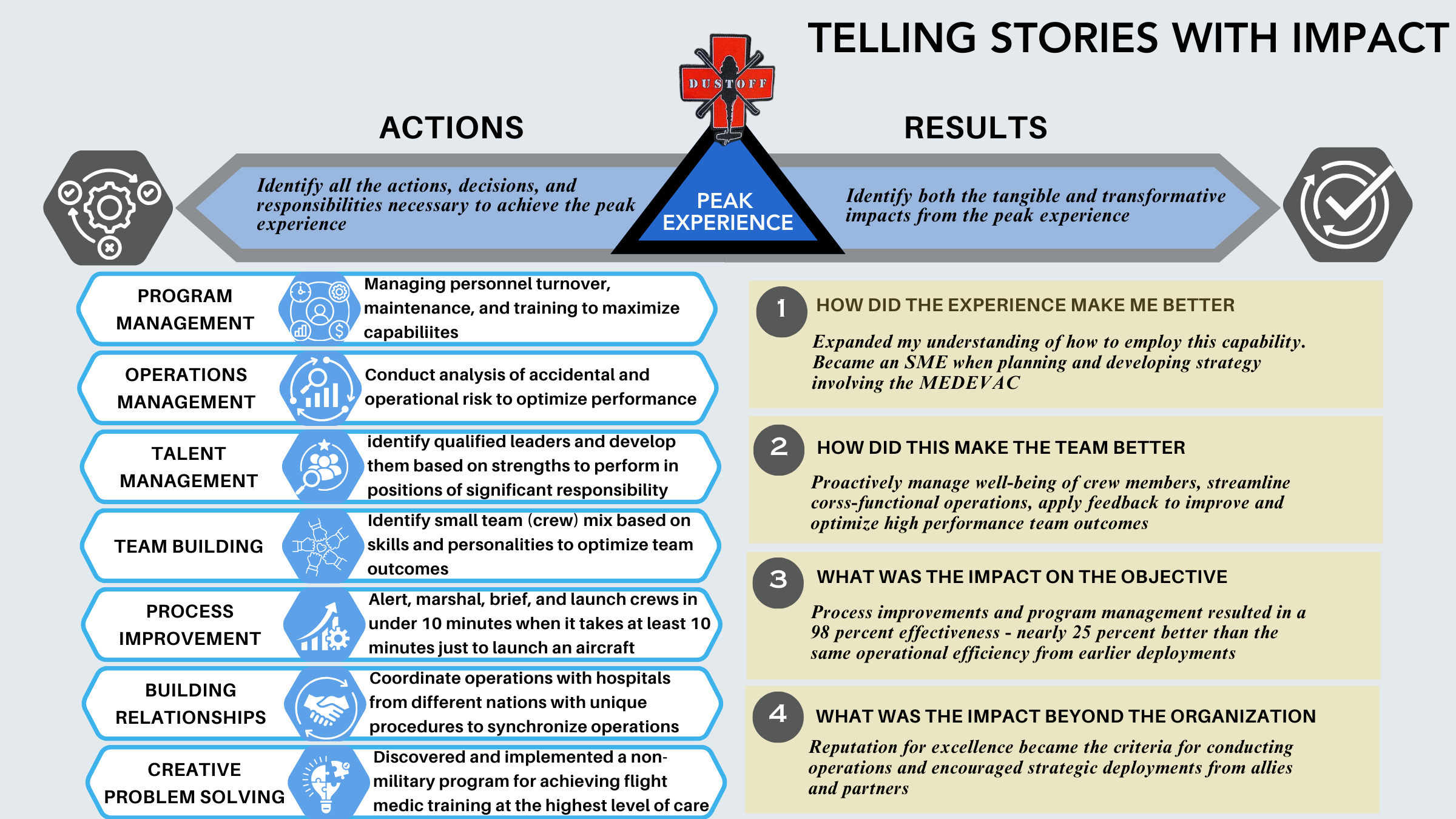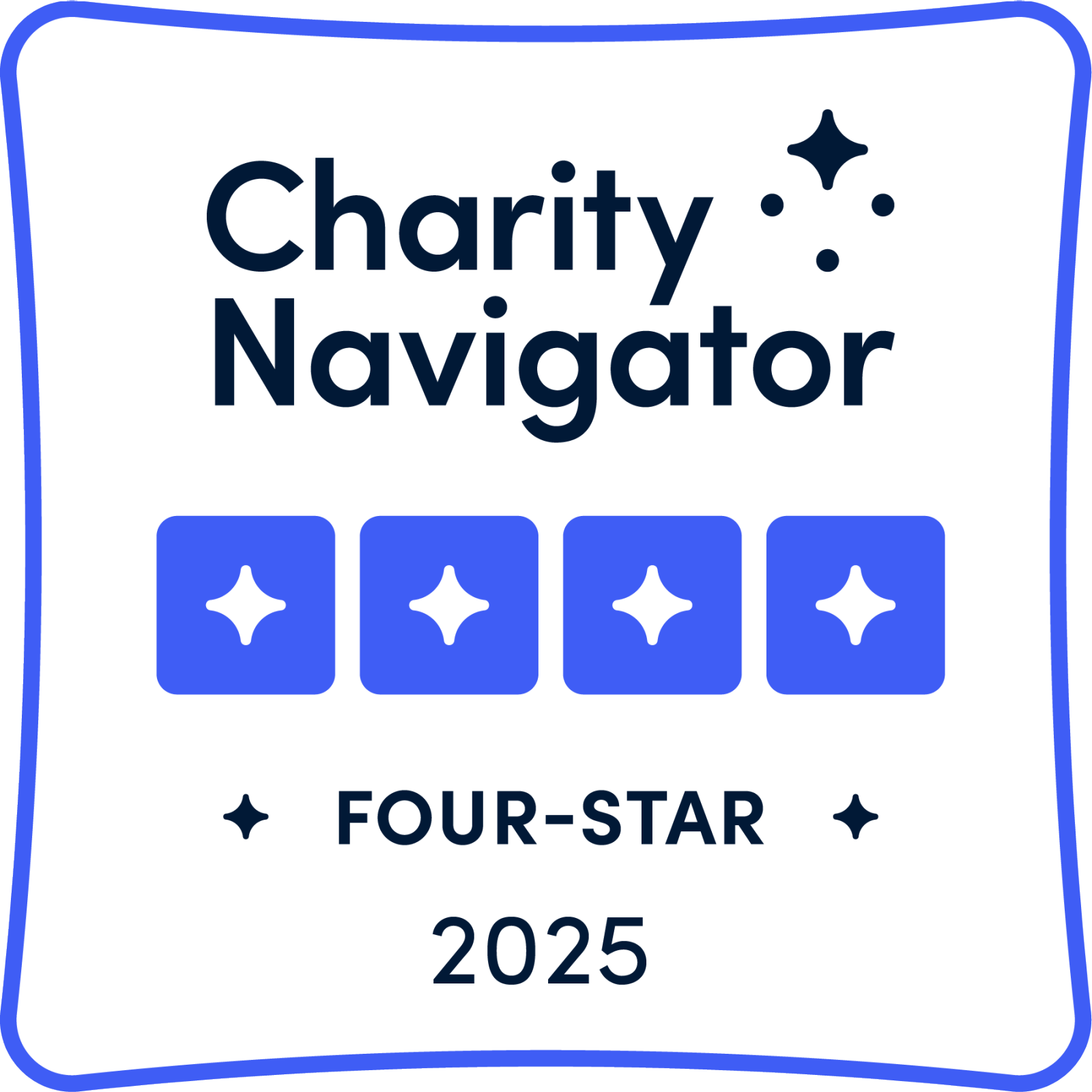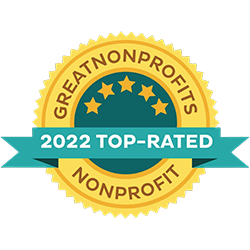
May 13, 2025
Storytelling: How to Move Past the Resume for More Meaningful Leadership Opportunities
Why is it so challenging for successful leaders to build a resume? It shouldn’t be hard. The recipe is quite simple. Skills. Knowledge. Experience. Boom . . . done. Use that document to polish your LinkedIn profile. Project qualifications. It’s a basic formula. It’s what you do to get hired. It is a methodology that reduces any applicant into a measurable commodity that can be sorted and compared to any other applicant. If this is your approach, then yes, you will find a job. You may not find purpose. You may not find your calling. That’s okay. You weren’t looking for those things. You were looking for a job. A job is what you got. If you want to make a difference in life beyond the military, perhaps the resume isn’t the right tool.
If you were to put everything you did over the past 10 to 20 years down on paper, your resume would be several pages long. Fitting your story into a single piece of paper can be overwhelming. So, you reduce the font. Expand the margins. Still hard. Still inadequate. How does a person with all that lived experience squeeze their story into a single piece of paper?
Here’s the thing. You can’t. The large square peg (story) doesn’t fit into the small round hole (resume). That’s the difference between an employee and a leader. You don’t just have skills, knowledge, and experience. You have the wisdom, intuition, and judgment that comes from real life application and implementation. You have the scars to show for it. Those scars speak your truth. They tell a story that is more valuable than any skill, credential, or diploma. If you want to make a difference in life beyond the military, speaking that truth through meaningful conversations is and will always be more effective for advocating your value proposition than preparing and distributing any single piece of paper.
Why We Struggle to Tell Our Story
When it comes to storytelling, military leaders have several biases working against them. First, we come from a culture of forced humility. You aren’t supposed to talk about yourself. Unless, of course, you are accepting responsibility for something that went wrong. You are supposed to promote the team. Promoting yourself is received poorly. Second, our style of storytelling doesn’t resonate with people who haven’t served in the military.
Think about how we tell our tales of adventure with other service members: “There I was . . . alone and unafraid.” We continue: “Oh, by the way, we had this going on . . . oh, by the way, we didn’t have this resource . . . and oh, by the way . . .” Does that sound familiar? We focus on the situation and context. We do this because we make assumptions that our audience has a baseline of understanding about our role. For example, if I tell you that I was working as a task force operations officer, you can reasonably assume what responsibilities, actions, and behaviors were necessary for the organization to succeed. Same is true if I said I was a command sergeant major or an action officer at the Pentagon. If you are successful, we already know what you have to do. Unfortunately, the same can’t be said when talking to people who never served in the military. Words like commanding officer, squad leader, or operations officer mean nothing to them. Consequently, the story doesn’t connect. If the story doesn’t connect, you will not impress your audience - regardless of the evaluations in your file or the medals in your foot locker.
How to Use a Single Event to Tell A Meaningful Story
So how do you tell stories that communicate your true value? Let’s start with mindset. Prioritize connection over fascination. Yes, your stories of combat are exciting. But exciting from the past and meaningful for the future are two different things. Let’s look at an example. I can tell exciting stories about flying MEDEVAC in Afghanistan. Call comes in. Sprint to the aircraft. Pull in max power. Take fire inbound. Load severely wounded casualties. Saving lives. Wow. But if I use that story to convey my value to someone who has never served (which amounts to almost 94 percent of the population), it is highly irrelevant. You may captivate your audience with tales of adventure, but that won’t convince them why they should trust you with a high level of authority or responsibility. The noted exception in this example, of course, is if you happen to interview for a helicopter evacuation crew at a hospital.
How do you communicate value from the story? There are two elements to address: The actions and the results. There are plenty of storytelling formats (STAR, Situation Behavior Impact, RATS, etc.) that delineate actions and results because that is what matters to the audience. The context is less important. They will not likely understand the meaning or scope of responsibility from your duty title. Actions and results are the parts that matter to the audience, so focus on those.
Let’s begin with the results. Start with a pinnacle event in your career. Look right and assess the impact from that peak experience by answering these four questions: (1) How did it make you better? (2) How did it make the team better? (3) What impact did this experience have on the organization (internal), and (4) What impact did the results have on the client, market, or broader community (external)? Describe those results using what is important to the organization regarding leadership, growth, and impact.
When it comes to the actions, look left of the peak experience. Way left. Identify all the things that were necessary to set yourself and the team up to achieve that success. For general guidance, look back about a year. Let’s use the MEDEVAC example to illustrate. Think about what was required to prepare the unit for deployment. Man, equip, and train are programs that you have to synchronize. You have to manage talent. Make difficult decisions with incomplete information. Consider the operations analysis that goes into the risk assessment process. Team building for high performance. Processes that you have to establish and optimize in theater: How you review and optimize those processes given the capabilities and limitations of your team. Maintain a finger on the pulse of culture and morale. Think about how you maximize your capabilities to support missions. Think about how you integrate personnel, equipment, and operational concerns into your decision making. Contingency planning. Consequence management. Consider the relationships you had to build across organizations with international partners - stakeholders with different and often competing equities. All of these actions were essential to make that high risk event a routine activity. All of those actions have potential value outside the military. When these actions connect to the responsibilities, intentions, and strategy of a nonmilitary organization it provides the context and meaning to communicate your potential.
Who needs to hear the story? That’s an important question. Your story is a representation of who you are. More so than a resume. It has an emotive quality. If true leadership is about inspiring others to action, target those individuals you want to inspire. Namely the women and men in positions with responsibility and authority. It’s not the hiring manager. It’s not the recruiter. It probably isn’t anyone from the HR department. You find your audience through application portals online. Step beyond the people looking for skills, knowledge, and experience. You want to talk to the strategic minds and executives who want to make an impact. If you fancy yourself a leader, you need to show up as one through the networking and interview process. In other words, be resourceful. Be genuine. Be engaging. The objective is to connect and inspire - whether you have a five minute conversation or a five decade career. If you want to make an impact, demonstrate it through your conversation. Leaders leave impressions. Not business cards.
Why don’t transition programs focus so much on resumes and not on storytelling? Because most of the service members in transition aren’t senior leaders and retirees. Once you get to the E8, O5, and W4 ranks, you are only talking about 5-10 percent of the transitioning population. The focus of the job search for a younger population includes knowledge, skills, and experience. That’s how they get their foot in the door with hiring managers and recruiters. Senior level leaders typically get connected to the opportunities that you won’t find advertised on a job board. You only discover these jobs through networking. You get hired because your story helps that organization tell a better story.
Preparing for Tomorrow’s Opportunities With Your Story Today
Storytelling is hard. Especially when the story you tell is the one you are currently living. It is hard to see yourself in a way that allows us to share it both honestly and objectively. Because we live it, we also don’t appreciate it. The story is polluted with our insecurities and biases. This is where a coaching partnership is so valuable. A good coach will give you awareness to see the story. An elite coach will empower you with the confidence to tell it. This is what makes an organization like The COMMIT Foundation so essential in the military transition space.
Scrambling to obtain those last minute certifications and credentials won’t help. Think about it. How does a six month training program compare to your decades of lived experience? It doesn’t. Sure, the recruiter or hiring manager might care about those skills or qualifications, but that isn’t the person you are targeting. Unless you just want to find a job. It’s not the person you talk to if you are looking for purpose. It’s not the person you talk to if you want to make a difference. Consider this . . . my 17 year old son got a PMP certification through his high school. He doesn’t even have a resume. Is that really the right rubric to accurately assess your value?
Storytelling is a part of the human condition. Since the dawn of civilization, we have used stories to communicate and shape the human experience. Whether you are sitting around a campfire or transforming your community, your story represents your most powerful offering. It’s not supposed to be compressed into a resume. It is only meant to be told. Shared by you. To shape the lives of others with purpose and meaning . . . to lead.
 Back to all blogs
Back to all blogs




